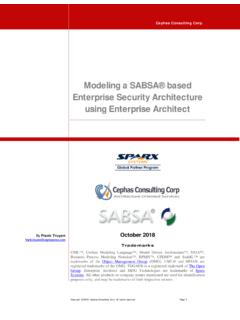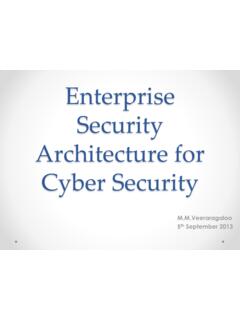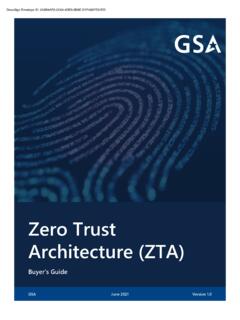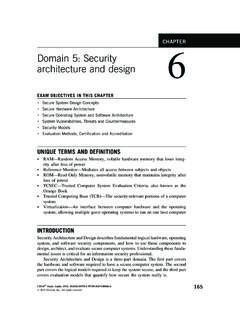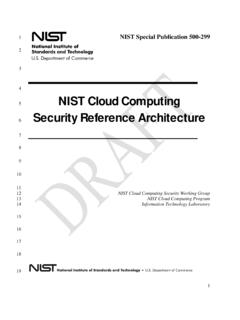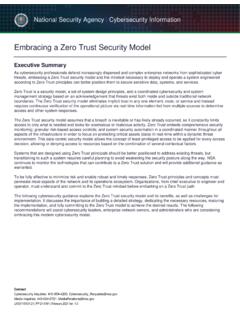Transcription of Data Center Architecture Overview - Cisco
1 CHAPTER 1-1 Cisco data Center Infrastructure Design GuideOL-11565-011 data Center Architecture OverviewNoteImportant Updated content: The Cisco Virtualized Multi-tenant data Center CVD ( ) provides updated design guidance including the Cisco Nexus Switch and Unified Computing System (UCS) chapter is an Overview of proven Cisco solutions for providing Architecture designs in the enterprise data Center , and includes the following topics: data Center Architecture Overview data Center Design ModelsData Center Architecture OverviewThe data Center is home to the computational power, storage, and applications necessary to support an enterprise business.
2 The data Center infrastructure is central to the IT Architecture , from which all content is sourced or passes through. Proper planning of the data Center infrastructure design is critical, and performance, resiliency, and scalability need to be carefully considered. Another important aspect of the data Center design is flexibility in quickly deploying and supporting new services. Designing a flexible Architecture that has the ability to support new applications in a short time frame can result in a significant competitive advantage.
3 Such a design requires solid initial planning and thoughtful consideration in the areas of port density, access layer uplink bandwidth, true server capacity, and oversubscription, to name just a data Center network design is based on a proven layered approach, which has been tested and improved over the past several years in some of the largest data Center implementations in the world. The layered approach is the basic foundation of the data Center design that seeks to improve scalability, performance, flexibility, resiliency, and maintenance.
4 Figure 1-1 shows the basic layered design. 1-2 Cisco data Center Infrastructure Design GuideOL-11565-01 Chapter 1 data Center Architecture Overview data Center Architecture OverviewFigure 1-1 Basic Layered DesignThe layers of the data Center design are the core, aggregation, and access layers. These layers are referred to extensively throughout this guide and are briefly described as follows: Core layer Provides the high-speed packet switching backplane for all flows going in and out of the data Center . The core layer provides connectivity to multiple aggregation modules and provides a resilient Layer 3 routed fabric with no single point of failure.
5 The core layer runs an interior routing protocol, such as OSPF or EIGRP, and load balances traffic between the campus core and aggregation layers using Cisco Express Forwarding-based hashing algorithms. Aggregation layer modules Provide important functions, such as service module integration, Layer 2 domain definitions, spanning tree processing, and default gateway redundancy. Server-to-server multi-tier traffic flows through the aggregation layer and can use services, such as firewall and server load balancing, to optimize and secure applications.
6 The smaller icons within the aggregation layer switch in Figure 1-1 represent the integrated service modules. These modules provide services, such as content switching, firewall, SSL offload, intrusion detection, network analysis, and more. Access layer Where the servers physically attach to the network. The server components consist of 1RU servers, blade servers with integral switches, blade servers with pass-through cabling, clustered servers, and mainframes with OSA adapters. The access layer network infrastructure consists of modular switches, fixed configuration 1 or 2RU switches, and integral blade server switches.
7 Switches provide both Layer 2 and Layer 3 topologies, fulfilling the various server broadcast domain or administrative Gigabit EthernetGigabit Ethernet orEtherchannelBackupCampus Core 1-3 Cisco data Center Infrastructure Design GuideOL-11565-01 Chapter 1 data Center Architecture Overview data Center Design ModelsThis chapter defines the framework on which the recommended data Center Architecture is based and introduces the primary data Center design models: the multi-tier and server cluster models. data Center Design ModelsThe multi-tier model is the most common design in the enterprise.
8 It is based on the web, application, and database layered design supporting commerce and enterprise business ERP and CRM solutions. This type of design supports many web service architectures, such as those based on Microsoft .NET or Java 2 Enterprise Edition. These web service application environments are used by ERP and CRM solutions from Siebel and Oracle, to name a few. The multi-tier model relies on security and application optimization services to be provided in the server cluster model has grown out of the university and scientific community to emerge across enterprise business verticals including financial, manufacturing, and entertainment.
9 The server cluster model is most commonly associated with high-performance computing (HPC), parallel computing, and high-throughput computing (HTC) environments, but can also be associated with grid/utility computing. These designs are typically based on customized, and sometimes proprietary, application architectures that are built to serve particular business 2, data Center Multi-Tier Model Design, provides an Overview of the multi-tier model, and Chapter 3, Server Cluster Designs with Ethernet, provides an Overview of the server cluster model.
10 Later chapters of this guide address the design aspects of these models in greater ModelThe multi-tier data Center model is dominated by HTTP-based applications in a multi-tier approach. The multi-tier approach includes web, application, and database tiers of servers. Today, most web-based applications are built as multi-tier applications. The multi-tier model uses software that runs as separate processes on the same machine using interprocess communication (IPC), or on different machines with communications over the network.










